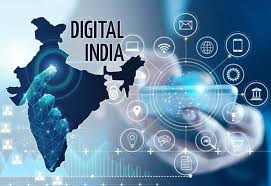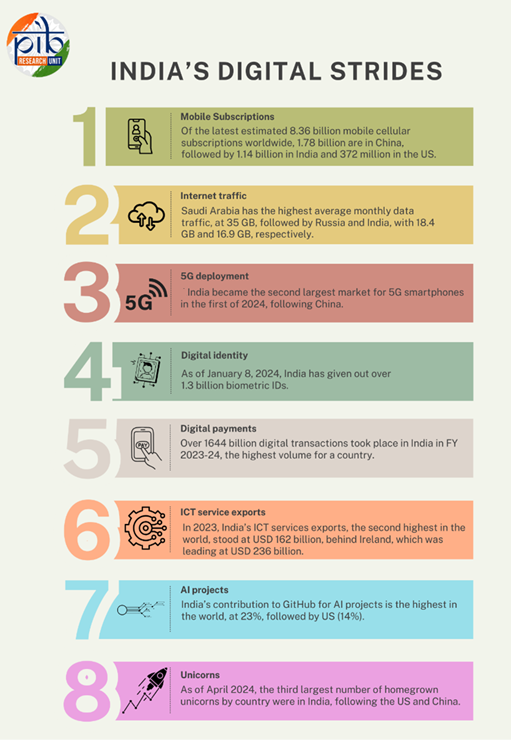

The digital economy refers to the economic activities that emerge from connecting individuals, businesses, devices, data and operations through digital technology. It encompasses the online connections and transactions that take place across multiple sectors and technologies, such as the internet, mobile technology, big data and information and communications technology.
The Indian economy has been digitalising at a remarkable pace over the last decade leading to higher economic growth and employment. The digital economy is nearly 5 times more productive than the rest of the economy.
India’s digital economy is expected to grow almost twice as fast as the overall economy, contributing to nearly 20% of national income by 2029-30. This means that, in less than six-years, the share of digital economy will become larger than that of agriculture or manufacturing in the country, because the agriculture contributes 16% to the economy and the manufacturing contributes 14.5% to the economy.
India’s digital economy has emerged as a significant contributor to its economic growth, accounting for 11.74% of the GDP which equals ₹31.64 lakh crore or USD 402 billion in 2022-23. The digital economy accounted for 4.5 per cent of India's GDP in 2014, and now is expected to contribute 20 per cent of the GDP by 2026.
It also employs 1.47 crore workers which is nearly 2.55% of the workforce. Though the workforce is predominantly male, digital platforms have contributed to increasing job opportunities for women, especially in sectors where mobility and safety concerns were previously barriers.
In addition to itself, the digital economy has contributed to the growth of related industries such as Information and communication technologies (ICT) services and manufacturing of electronic components, computers, and communication equipment, which has contributed 7.83% of Gross Value Added or GVA. Furthermore, digitalisation in traditional sectors like Banking, Financial services and Insurance (BFSI), retail, and education added 2% of GVA, showcasing the pervasive impact of digital transformation.
As on March 2024, the Telecom Regulatory Authority of India (TRAI) data suggests nearly 120 crore telecom subscribers in India. Total number of internet subscribers increased from 88.1 crore in March 2023 to 95.4 crore at the end of March 2024, close to half are from rural areas. Over 7.3 crore internet subscribers and over 7.7 crore broadband subscribers were added in last one year.

Driven by adoption of 4G and 5G technologies, total volume of wireless data usage increased from 1,60,054 PB during the year 2022-23 to 1,94,774 PB during the year 2023-24 with yearly growth of 21.69 per cent. (A petabyte (PB) is a large unit of data storage, equivalent to 1,000 terabytes (TB) or 1,000,000 gigabytes (GB))
Between 2017 and 2023, retail digital payments surged 50.8 per cent. Sectors like finance, education, healthcare, food, travel and e-commerce are already undergoing large-scale digital transformation. In the BFSI sector, over 95% of banking payment transactions are digital. As per the report, UPI, is expected to contribute 90 per cent of the total retail digital payments in India by 2027.
Projections indicate the digital economy’s share will grow to 20% of GVA by 2029-30, outpacing agriculture and manufacturing. Key growth drivers include the rapid adoption of AI, cloud services, and the rise of global capability centers (GCCs), with India hosting 55% of the world’s GCCs. GCCs are offshore centres established by multinational corporations to provide a variety of services to their parent organisations, including R&D, IT support, and business process management.
Retail is shifting to omni-channel models, with e-tailers adding physical stores, while AI chatbots and digital inventory tools enhance efficiency. Education has begun adopting offline, online, and hybrid models, with most institutions favoring hybrid approaches. Hospitality and logistics are embracing AI, metaverse, and digital tools, with large firms fully digitalising operations, while smaller players lag behind.
Comments
Write Comment